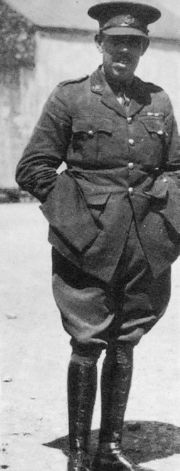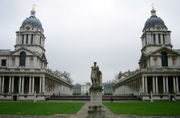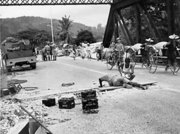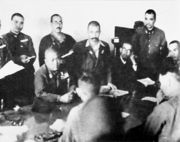Arthur Ernest Percival
2007 Schools Wikipedia Selection. Related subjects: Military People
| Arthur Ernest Percival | |
|---|---|
| December 26, 1887 – January 31, 1966 | |
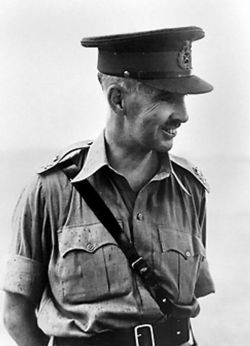 GOC Malaya in December 1941. |
|
| Place of birth | Aspenden, Hertfordshire |
| Allegiance | British Army |
| Years of service | 1914-1946 |
| Rank | Lieutenant-General |
| Commands | General Officer Commanding Malaya |
| Battles/wars | World War I Russian Civil War Anglo-Irish War Battle of Malaya Battle of Singapore |
| Awards | CB, DSO and bar, OBE, MC |
Lieutenant-General Arthur Ernest Percival, CB, DSO and Bar, OBE, MC, OStJ, DL ( December 26, 1887 - January 31, 1966) was a British Army officer and a World War I hero. He built a successful military career between the wars but is most noted for his involvement in World War II, when he commanded the British and Commonwealth army during the Battle of Malaya and the subsequent Battle of Singapore.
Percival's surrender to the smaller invading Japanese Army is the largest capitulation in British military history and fatally undermined Britain's prestige as an imperial power in the Far East. However, the years of under-funding of Malaya's defences combined with the inexperienced, under-equipped nature of the British and Commonwealth army makes it possible to hold a more sympathetic view of his command.
Early life
Childhood and Employment
Arthur Ernest Percival was born on Boxing Day in Aspenden Lodge, Aspenden near Buntingford in Hertfordshire, the second son of Alfred Reginald and Edith Percival (née Miller). His father was the Land Agent of the Hamel's Park estate and his mother came from a Lancashire cotton family.
Percival was initially schooled locally in Bengeo. Then in 1901 he was sent to Rugby with his more academically successful brother, where he was a boarder in School House. A moderate pupil, he studied Greek and Latin but was described by a teacher as "not a good classic". Percival's only qualification on leaving in 1906 was a higher school certificate. He was a more successful sportsman, playing cricket and tennis and running cross country. He also rose to colour sergeant in the school's Volunteer Rifle Corps. However, his military career began at a comparatively late age: although a member of Youngsbury Rifle Club, he was still working as a clerk for the iron-ore merchants, Naylor, Benzon & Company Limited in London, which he had joined in 1907 when the Great War broke out. But for this conflict, it seems certain that he would have remained a civilian.
Enlistment and World War I
Percival enlisted on the first day of the war as a private in the Officer Training Corps of the Inns of court, aged 26, and was promoted after five weeks' basic training to acting second lieutenant. Nearly one third of his fellow recruits would be dead by the end of the war.
The following year Percival was dispatched to France with the newly formed 7th (Service) Battalion of the Bedfordshire Regiment, which became part of the 54th Brigade, 18th (Eastern) Division in February 1915. The first day of the Battle of the Somme on 1 July 1916 left Percival unscathed, but he was badly hurt by shrapnel wounds in four places in September as he led his company in an assault on the Schwaben Redoubt beyond the ruins of Thiepval village and was awarded the Military Cross.
Percival took a regular commission as a captain with the Essex Regiment in October 1916, whilst recovering from his injuries in hospital. In 1917, he became battalion commander with the temporary rank of lieutenant-colonel. During Germany's Spring Offensive, Percival led a counter-attack that saved a unit of French artillery from capture, winning a Croix de Guerre. For a short period in May 1918, he acted as commander of the 54th Brigade. He was awarded the Distinguished Service Order, with his citation noting his "power of command and knowledge of tactics".He ended the war as a respected soldier, described as "very efficient" and was recommended for the Staff College.
Between the Wars
Russia
Percival's studies were delayed in 1919 when he decided to volunteer for service with the Archangel Command of the British Military Mission during the North Russia Campaign of the Russian Civil War. Appointed brevet major and acting as second-in-command of the 46th Royal Fusiliers, he earned a bar to his DSO in August, when his attack in the Gorodok operation along the Dvina netted 400 Bolshevik prisoners.
Ireland
More controversially, in 1920 Percival served as a company commander and later the intelligence officer of the 1st Battalion, the Essex Regiment in Kinsale, County Cork, Ireland fighting the IRA during the Anglo-Irish War.
Percival was a successful counter-guerrila but he soon developed a reputation for brutality amongst the Irish people: following the murder of an RIC sergeant in church in July 1920, he captured Tom Hales, commander of the West Cork Brigade, and Patrick Harte, the brigade's quartermaster, and won an OBE. But there were allegations that these and other prisoners were maltreated whilst in custody and he was unable to jail Tom Barry in spite of once having the opportunity to interrogate him.
The IRA placed a bounty of £1,000 on Percival's head, seeing him as responsible for the "Essex Battalion Torture Squad", and a first attempted assassination was only foiled when Percival departed from his dinnertime routine. A second hit squad was dispatched to London in March 1921 but was forced to flee Liverpool Street Station when the police learned of their plans. Back in Ireland, Percival led a raid that killed one of the would-be hitmen.
Whilst in Ireland, Bernard Montgomery, who was serving in the same brigade, made Percival's acquaintance and they later exchanged letters on their experiences in this war. David Lloyd-George and Winston Churchill also met Percival in 1921 when he was called as an expert witness during an inquiry into the Anglo-Irish War.
Staff officer
Percival attended the Staff College, Camberley from 1923 to 1924, then commanded by General Edmund Ironside, where he was taught by J.F.C. Fuller, who was one of the few sympathetic reviewers of his book, The War in Malaya, twenty five years later. He impressed his instructors, who picked him out as one of eight students for accelerated promotion, and his fellow students who admired his cricketing skills. Following an appointment as major with the Cheshire Regiment, he spent four years with the Nigeria Regiment of the Royal West African Frontier Force in West Africa as a staff officer.
In 1930, Percival spent a year studying at the Royal Naval College, Greenwich. From 1931 to 1932, Percival was General Staff Officer Grade 2, an instructor at the Staff College. The College's commandant General Sir John Dill, became Percival's mentor over the next 10 years, helping to ensure his protégé's advancement. Dill regarded Percival as a promising officer and wrote that "he has an outstanding ability, wide military knowledge, good judgement and is a very quick and accurate worker" but added "he has not altogether an impressive presence and one may therefore fail, at first meeting him, to appreciate his sterling worth". With Dill's support, Percival was appointed to command the 2nd Battalion, the Cheshire Regiment from 1932 to 1936, initially in Malta. In 1935, he attended the Imperial Defence College.
Percival was made a full colonel and from 1936 to 1938 he was General Staff Officer Grade 1 in Malaya, the Chief of Staff to General Dobbie, the General Officer Commanding in Malaya. During this time, he recognised that Singapore was no longer an isolated fortress. He considered the possibility of the Japanese landing in Thailand to "burgle Malaya by the backdoor and conducted an appraisal of the possibility of an attack being launched on Singapore from the North, which was supplied to the War Office, and which Percival subsequently felt was similar to the plan followed by the Japanese in 1941. He also supported Dobbie's unexecuted plan for the construction of fixed defences in Southern Johore. In March 1938, he returned to Britain and was promoted to brigadier on the General Staff, Aldershot Command.
Family
On 27 July 1927 Percival married Margaret Elizabeth "Betty" MacGregor (who died in 1956) in the Holy Trinity Church, West Brompton. She was the daughter of Thomas MacGregor Greer of Tallylagan Manor, a protestant linen merchant from County Tyrone in Ulster. They had met during his tour of duty in Ireland and it had taken Percival several years to propose. They had two children. A daughter, Dorinda Margery, was born in Greenwich and became Lady Dunleath. Alfred James MacGregor, their son, was born in Singapore and also served in the British Army. The family were well-to-do and Percival's estate on his death was valued at £102,515, a considerable sum in 1966.
The Second World War
Percival was appointed Brigadier, General Staff, of the I Corps, British Expeditionary Force, commanded by General Dill, from 1939 to 1940. He was then promoted to major general and in February 1940 briefly became General Officer Commanding 43rd (Wessex) Division. He was made Assistant Chief of the Imperial General Staff at the War Office in 1940 but asked for a transfer to an active command after the Dunkirk evacuation. Given command of the 44th (Home Counties) Infantry Division, he spent 9 months organising the protection of 62 miles of the English coast from invasion. He was created Companion of the Order of the Bath (CB) in 1941.
General Officer Commanding (Malaya)
In May 1941 Percival was given a temporary promotion to acting lieutenant-general and was appointed General Officer Commanding (GOC) Malaya. This was a significant promotion for him as he had never commanded an army Corps. He left Britain in a Sunderland flying boat and embarked on an arduous two week, multi-stage flight via Gibraltar, Malta, Alexandria, where he was delayed by the Anglo-Iraqi War, Basra, Karachi and Rangoon, where he was met by an RAF transport.
Percival had mixed feelings about his appointment, noting that "In going to Malaya I realised that there was the double danger either of being left in an inactive command for some years if war did not break out in the East or, if it did, of finding myself involved in a pretty sticky business with the inadequate forces which are usually to be found in the distant parts of our Empire in the early stages of a war."
For much of the inter-War period, Britain's defensive plan for Malaya had centred on the dispatch of a naval fleet to the newly built Singapore Naval Base. Accordingly, the army's role was to defend Singapore and Southern Johore. Whilst this plan had seemed adequate when the nearest Japanese base had been 1,700 miles away, the outbreak of war in Europe combined with the partial Japanese occupation of the Northern part of French Indochina and the signing of the Tripartite Pact in September 1940 had underlined the impossibility of a sea based defence. Instead it was proposed to use the RAF to defend Malaya, at least until reinforcements could be dispatched from Britain. This led to the building of airfields in Northern Malaya and along its East coast and the dispersal of the available army units around the peninsula to protect them.
On arrival Percival set about training his inexperienced army, with his Indian troops being particularly raw, with most of their experienced officers having been withdrawn to support the formation of new units as the Indian army expanded. Relying upon commercial aircraft or the Volunteer air force to overcome the shortage of RAF planes, he toured the peninsula and encouraged the building of defensive works around Jitra. A training manual, Tactical Notes on Malaya, approved by Percival was distributed to all units.
In July 1941 the Japanese occupied Southern Indochina and sanctions were invoked by Britain, the United States and the Netherlands, freezing financial assets and cutting Japan off from its supplies of oil, tin and rubber. Given their on-going involvement in China, this put Japan in an unsustainable position. Both the Japanese navy and army were mobilised but for the moment an uneasy state of cold war persisted. British and Commonwealth reinforcements continued to trickle into Malaya. On 2 December, the battleship HMS Prince of Wales and the battle-cruiser HMS Repulse, escorted by four destroyers arrived in Singapore, the first time a battle fleet had been based there. The following day Rear-Admiral Spooner hosted a dinner attended by the newly arrived Commander-in-Chief Eastern Fleet Admiral Tom Phillips and Percival.
The Japanese attack and the British surrender
On December 8, 1941 the Japanese 25th Army under the command of Lieutenant-General Tomoyuki Yamashita landed on the Malay Peninsula (one hour before the attack on Pearl Harbour, the difference in date being because of the international date line). That night the first Japanese invasion force arrived at Kota Bharu on Malaya's East coast. This was just a diversionary force and the main landings took place the next day at Singora and Pattani on the south-eastern coast of Thailand, with troops rapidly deploying over the border into Northern Malaya.
On 10 December, Percival issued a stirring, if ultimately ineffective, Special Order of the Day:
- In this hour of trial the General Officer Commanding calls upon all ranks Malaya Command for a determined and sustained effort to safeguard Malaya and the adjoining British territories. The eyes of the Empire are upon us. Our whole position in the Far East is at stake. The struggle may be long and grim but let us all resolve to stand fast come what may and to prove ourselves worthy of the great trust which has been placed in us.
The Japanese advanced rapidly and on 27 January 1942 Percival ordered a general retreat across the Johore Strait to the island of Singapore and organised a defence along the length of the island's 70 mile coast line. But the Japanese did not dawdle and on 8 February, Japanese troops landed on the northwest corner of Singapore island. After a week of fighting on the island, Percival held his final command conference at 9 am on 15 February in the Battle Box of Fort Canning. Having been told that ammunition and water would both run out by the following day, it was agreed to surrender.
The Japanese insisted that Percival himself, march under a white flag to the Old Ford Motor Factory in Bukit Timah to negotiate the surrender. A Japanese officer present noted that he looked "pale, thin and tired". After a brief disagreement, when Percival insisted that the British keep 1,000 men under arms in Singapore to preserve order, which Yamashita finally conceded, it was agreed at 6.10 pm that the British and Commonwealth troops would lay down their arms and cease resistance at 8.30 pm. This was in spite of instructions from Winston Churchill for prolonged resistance. The Pacific War was just ten weeks old.
A common view holds that 138,708 Allied personnel surrendered or were killed by fewer than 30,000 Japanese. However, the former figure includes nearly 50,000 troops captured or killed during the Battle of Malaya, and perhaps 15,000 base troops. Many of the other troops were tired and under-equipped following their retreat from the Malayan peninsula. Conversely, the latter number represents only the front-line troops available for the invasion of Singapore. British and Commonwealth battle casualties since 8 December amounted to 7,500 killed and 11,000 wounded. Japanese losses totalled around 3,500 killed and 6,100 wounded.
Culpability for the fall of Singapore
Churchill viewed the fall of Singapore to be "the worst disaster and largest capitulation in British history". However, Britain, the Middle East and the Soviet Union had all received higher priorities in the allocation of men and material, so the desired airforce strength of 300 to 500 aircraft was never reached and whereas the Japanese invaded with over two hundred tanks the British Army in Malaya did not have a single one.
In 1918, Percival had been described as "a slim, soft spoken man... with a proven reputation for bravery and organisational powers" but by 1945 this description had been turned on its head with even Percival's defenders describing him as "something of a damp squib". The fall of Singapore switched Percival's reputation to that of an ineffective "staff wallah", lacking ruthlessness and aggression, even though few doubted that he was a brave and determined officer. Over six feet in height and lanky, with a clipped moustache and two protruding teeth, Percival was an easy target for a caricaturist and decidedly unphotogenic, being described as "tall, bucktoothed and lightly built". . There was no doubt his presentation lacked impact as "his manner was low key and he was a poor public speaker with the cusp of a lisp" but it is equally clear that looks alone do not lose battles.
Percival's colleagues must share some of the responsibility. Air Chief Marshal Sir Robert Brooke-Popham, the Commander-in-Chief of the British Far East Command refused Percival permission to launch Operation Matador in advance of the Japanese landings in Thailand, not wishing to run any risk of provoking the coming war. Brooke-Popham also had a reputation for being "past it", falling asleep in meetings and not arguing forcefully for the air reinforcements required to defend Malaya. Whilst Admiral Tom Phillips was undoubtedly brave, his bold leadership of Force Z led to his demise and the destruction of the British fleet on 10 December 1941, early in the campaign.
Moreover, Percival had difficulties with his subordinates Sir Lewis "Piggy" Heath, commanding Indian III Corps, and the independent-minded Gordon Bennett, commanding the Australian 8th Division. The former officer had been senior to Percival prior to his appointment as GOC (Malaya) and found it difficult to serve under him. Bennett was full of confidence in his Australian troops, but many saw this as bravado with little basis in reality and he faced a mixed reaction in Australia when he escaped from Singapore immediately after its surrender.
That said, Percival was ultimately responsible for the men who served under him and with other officers, notably Major-General Murray-Lyon commander of the Indian 11th Infantry Division, he had shown a willingness to replace them when he felt their performance was not up to scratch. Perhaps his greatest mistake was to resist the building of fixed defences in either Johore or the north shore of Singapore, dismissing them in the face of repeated requests to start construction from his Chief Engineer, Brigadier Ivan Simson, with the comment "Defences are bad for morale - for both troops and civilians". In doing so, Percival threw away the potential advantages he could have derived from the 6,000 engineers under his command and perhaps missed his best chance to blunt the danger posed by the Japanese tanks. Percival also insisted on defending the North-Eastern shore of Singapore most heavily in spite of the wider Straits and against the advice of his new Commander-in-Chief General Wavell, perhaps fixed on his responsibilities for defending the Singapore Naval Base.
Captivity
Percival himself was briefly held prisoner in Changi Prison, where "the defeated GOC could be seen sitting head in hands, outside the married quarters he now shared with seven brigadiers, a colonel, his ADC, cook-sergeant and batman. He discussed feelings with few, spent hours walking around the extensive compound, ruminating on the reverse and what might have been". In the belief that it would improve discipline, he reconsituted a Malaya Command, complete with staff appointments, and helped occupy his fellow prisoners with lectures on the Battle of France.
Along with the other senior British captives above the rank of colonel, Percival was removed from Singapore in August 1942. First he was imprisoned in Formosa and then sent on to Manchuria, where he was held with several dozen other VIP captives including the American, General Jonathan Wainwright in a prisoner-of-war camp near Hsian, about 100 miles to the north east of Mukden.
As the war drew to an end, an OSS team removed the prisoners from Hsian. Percival was then taken, along with Wainwright, to stand immediately behind General Douglas MacArthur as he confirmed the terms of the Japanese surrender onboard the USS Missouri (BB-63) in Tokyo Bay on 2 September. Afterwards, MacArthur gave Percival one of the pens he had used to sign the treaty.
Percival and Wainwright then returned together to the Philippines to witness the surrender of the Japanese army there, which in a twist of fate was commanded by General Yamashita. The Tiger of Malaya was momentarily surprised to see his former captive at the ceremony. The flag carried by Percival's party on the way to Bukit Timah was also a witness to this reversal of fortunes, being flown when the Japanese formally surrendered Singapore back to Lord Louis Mountbatten.
Later life
Percival returned to Britain in September 1945 to write his dispatch at the War Office but this was revised by the Government and only published in 1948. He retired from the army in 1946 with the honorary rank of lieutenant-general but only the pension of a major-general. Thereafter, he held appointments connected with the county of Hertfordshire, where he lived at Bullards in Widford: he was Honorary Colonel of the 479th (Hertfordshire Yeomanry) H.A.A. Regiment T.A. from 1949-1954 and acted as one of the Deputy Lieutenants of Hertfordshire in 1951. He continued his relationship with the Cheshire Regiment being appointed Colonel of the Cheshire Regiment between 1950-1955; an association continued by his son, Brigadier James Percival who became Colonel of the Regiment between 1992 and 1999.
Whilst General Wainwright had become a public hero on his return to the United States, Percival found himself disparaged for his leadership in Malaya, even by Lieutenant-General Heath, his erstwhile subordinate. "The War in Malaya", Percival's memoir, published in 1949, did little to quell this criticism, being a restrained rather than self-serving account of the campaign. Unusually for a British lieutenant-general, Percival was not awarded a knighthood.
Percival was respected for the time he had spent as a Japanese prisoner-of-war. Serving as life president of the Far East Prisoners of War Association (FEPOW), he pushed for compensation for his fellow captives, eventually helping to obtain a token £5 million of frozen Japanese assets for this cause. This was distributed by the FEPOW Welfare Trust, which Percival served as Chairman. He led protests against the film the Bridge on the River Kwai, when it was released in 1957, obtaining the addition of on on-screen statement that the movie was a work of fiction. He also worked as President of the Hertfordshire British Red Cross and was made an Officer of the Order of St. John in 1964.
Percival died at the age of 78 on 31 January 1966, in King Edward VII's Hospital for Officers, Beaument Street in Westminster and was buried in Hertfordshire. Leonard Wilson, formerly the Bishop of Singapore gave the address at his memorial service, which was held in St Martin-in-the-Fields.

